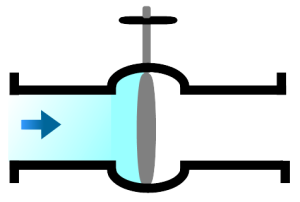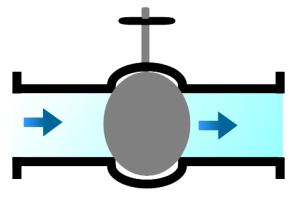Butterfly valves operate similarly to ball valves. They both open and close with a quarter-turn and are also considered shut-off valves, though butterfly valves are much better at regulating flow. This is the reason they are commonly used in engines for “throttling”.

As you can see, a closed butterfly valve has a thin profile stopping any flow. This thin profile makes the butterfly design weaker than its counterpart, the ball valve. That said, the thin profile allows for better flow around it and greater cross sectional area for less impeded flow, making it ideal for quick changes in flow.

Once opened, the cross-sectional view of a butterfly valve is identical to that of the ball valve with one notable difference. Fluids flow to the left and right of the mechanism instead of through a hole in the middle. There aren’t many uses for butterfly valves in typical residential/commercial plumbing applications. They are found more frequently in automotive and industrial systems.
Leave a Reply